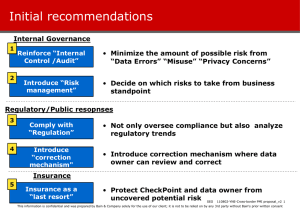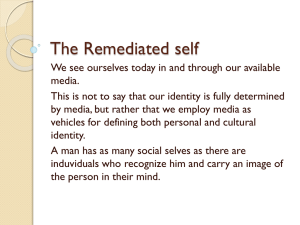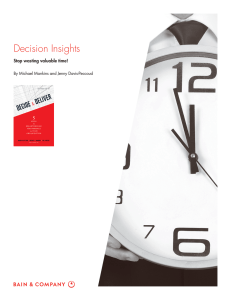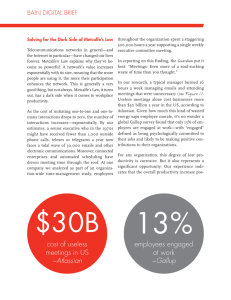Decision Insights: Networked organizations: Making the matrix work
advertisement
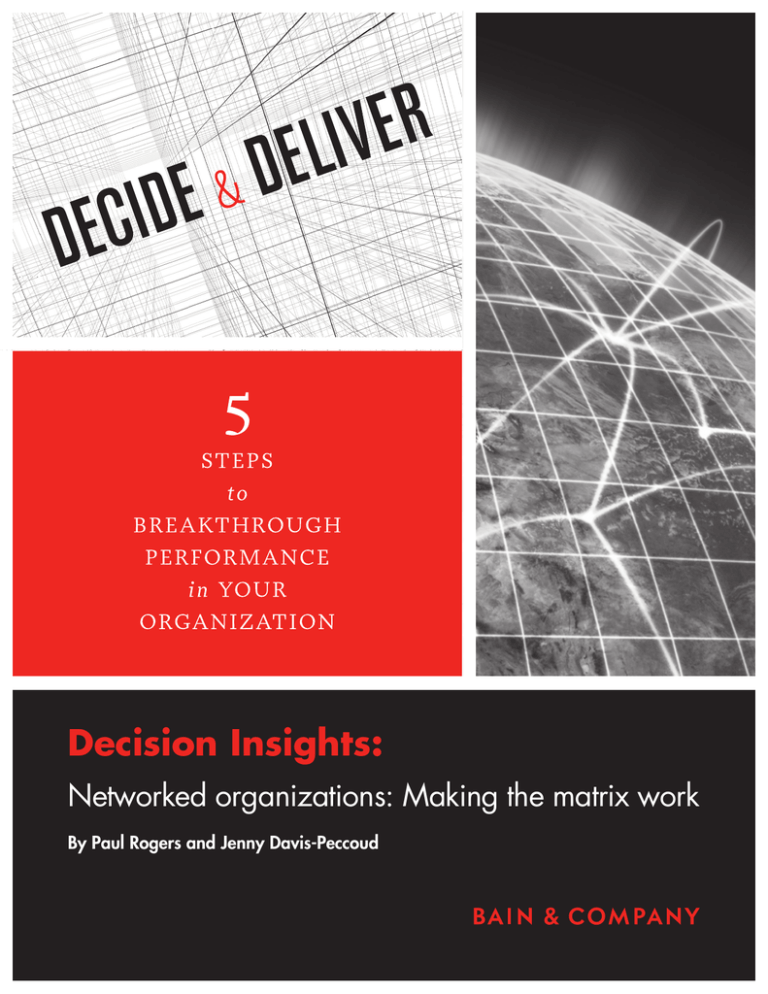
Decision Insights: Networked organizations: Making the matrix work By Paul Rogers and Jenny Davis-Peccoud Paul Rogers is the managing partner of Bain’s London office and leads Bain’s Global Organization practice. Jenny Davis-Peccoud is senior director of Bain’s Global Organization practice. She is based in London. Copyright © 2011 Bain & Company, Inc. All rights reserved. Content: Global Editorial Layout: Global Design Networked organizations: Making the matrix work You’re a country manager at a large equipment company. The company has made several acquisitions recently, and somehow it never fully incorporates the acquired organizations into its matrix management structure. Now you have three, four, even five bosses who must sign off on major decisions. You’re a product-design manager for a regional division of a global auto manufacturer. You believe your department has final responsibility for the features that will be included in every new car model. Unfortunately, most of your colleagues in marketing believe that they have final responsibility. The only way to get a decision is to escalate the dispute to executives too high up and too busy to understand the necessary trade-offs. You run a factory for a UK–based packaging company. You have always dealt with local customers, and those customers have appreciated the fact that they could call you to, for example, change the production run. Now the CEO has created a Europe-wide organization with separate groups handling sales and manufacturing. You no longer have direct contact with your local customers— and they are not happy about it. Making the matrix work: 10 lessons for successful management in today’s networked organizations two masters, so it is said, is likely to die of hunger. So most companies have consigned this kind of rigid matrix to history’s dustbin. Welcome to the matrix organization, also known as the networked or “boundaryless” company. It’s a world of multiple bosses, endless solid-line and dotted-line reporting relationships and—as these three real-world examples show—murky accountabilities. It’s also a world of frustrated managers and employees, people who feel that they can’t take effective action or deal with a customer without running into a series of organizational obstacles. In this article we will offer 10 interrelated techniques for clearing away those obstructions. And we’ll try to show you how your company can make the matrix into an engine of high performance. But some form of more sophisticated matrix is essential for running any large, complex organization. A global consumer products company, for instance, must respond to local market needs and capitalize on global economies of scale. It needs organizations at both levels, and it needs the ability to manage across those boundaries— a matrix, in other words. In today’s world, moreover, the complexity of any matrix is likely to increase. That same company might also need programs for global functional excellence, for example. As one CEO puts it, “the matrix is becoming a cube.” Indeed, when executives talk about crossing organizational boundaries, in our experience, they’re likely to mean not one or two boundaries but five or six, such as function, geographical region, process, product, customer and channel. Basics first. Originally, the matrix involved shared profit-and-loss accountability. The double solid lines on the organization chart indicated that at least two executives bore equal responsibility for a P&L. Many managers reported directly to two bosses, both of whom technically had authority for specific decisions. This was almost always a recipe for organizational confusion; a dog with The trouble is that many companies have not yet mastered this multifaceted matrix. People find it hard to get things done. The company loses opportunities. Good employees get fed 1 Networked organizations: Making the matrix work up and begin to look elsewhere. Individuals who thrive in this sluggish environment tend to focus more on managing bureaucratic processes than on achieving business results. The decision approach. To make the matrix work—to turn it from a drag on performance into a source of support—requires a company to redirect its attention. Instead of concentrating on the solid or dotted lines of the org chart, leaders in effective matrix organizations focus on decisions. Decisions, after all, determine performance. Better, faster decisions and better, faster execution naturally produce better results than do poor, slow or badly executed decisions. This connection between decisions and results is intuitive; it’s also supported by data that we gathered from more than 760 companies around the world. Decision effectiveness and financial results correlate at a 95 percent confidence level or higher for every country, industry and company size we studied.1 Companies that rate best on decision effectiveness take two steps that other companies often ignore. First, they identify and concentrate on their most important decisions. This category includes not only the obvious candidates—big decisions involving a lot of resources—but also the routine everyday decisions that deliver (or fail to deliver) a great deal of value over time. Second, these companies work hard to optimize not just the quality of their key decisions but also decision speed, execution and the degree of effort involved. High performance organizations excel on all four dimensions. A well-functioning matrix can actually help decision effectiveness rather than hinder it. The key lies in the 10 lessons summarized in Figure 1. We’ll add a brief word of explanation about each one. 1. Follow the money. High-performing matrixbased companies know how each side of the Figure 1: 10 keys to successful matrix management 1. Follow the money. Clarify how different sides of the matrix drive value in the business and which decisions are key to unlocking it. 2. Align people around priorities and principles. Give people the context they need to make decisions. 3. Assign P&L responsibility to the matrix’s dominant side. 4. Assign clear decision roles—who decides, who gets input and who gets out of the way. 5. Design decision processes that bring different parts of the matrix together. 6. Ensure consistent, transparent information flows, with systems to support these flows. 7. Develop people with the “will and skill” needed to manage in a matrix. 8. Tailor incentives to foster crossboundary collaboration. Measure and reward managers on overall performance, not just their piece. 9. Support leaders to live the right behaviors. Clarity and alignment Structure and roles Processes and information People and incentives Leadership and culture 10. Foster a performance culture. 2 Networked organizations: Making the matrix work matrix creates value and which decisions are key to unlocking that value. That helps them locate critical decisions at the appropriate points in the organization. The wireless telecom company Vodafone, for instance, grew rapidly by acquisition, buying up a series of stand-alone country-based businesses. But then Vodafone saw opportunities for global scale advantage in three key areas—innovation, procurement and the development of best practices in marketing. All could unlock the potential synergy of the acquisitions. So it created a matrix with countrybased businesses plus global functions in the three areas where the additional complexity actually added value. 2. Align people around priorities and principles. Successful companies usually operate according to a set of strongly held beliefs and values regarding their business. These core principles and priorities supersede any matrix; they create a context enabling people anywhere in the organization to make appropriate trade-offs. At British American Tobacco (BAT) several years ago, then-CEO Martin Broughton eliminated internal competition and established a few overarching priorities that he believed would help BAT regain the top spot in its industry. BAT’s new priority of growth in premium global brands, for example, allowed global marketers and local salespeople to focus their joint attention on decisions relating to this objective. 3. Assign P&L responsibility to the matrix’s dominant side. An effective matrix doesn’t fudge accountability for the P&L. Its dominant vector should be the one that generates most of the value. Nestlé, for example, relies on a global P&L for water because customer needs and the business’s strategic positioning are much the same the world over. Nestlé employs regional P&Ls for food categories because most of the value in that business derives from tailoring products to local needs. The goal here isn’t perfection, which is unattainable; it is simply to deliver as much value as possible while specifying who has ultimate accountability. 4. Assign clear decision roles. People can have more than one boss, but decisions can’t. Indeed, the single most common problem we find in matrix organizations is confusion over who should play which role in key decisions. We use a tool called RAPID®—Recommend, Agree, Perform, Input and Decide—to ensure that every role in an important decision is assigned to a specific individual or group. Assigning decision-making authority, for instance, ends the confusion often inherent in matrix-based management. Remember the automobile company mentioned earlier, where product development and marketing were at loggerheads? The organization finally broke the bottleneck by specifying decision rights: product development would decide on a menu of affordable features and marketing would select the final features from the list consistent with customer demand. 5. Design decision processes that bring different parts of the matrix together. Committees and meetings can be an efficient way to get people from different sides of a matrix together to discuss and decide. But companies need to plan and structure such meetings carefully. Only those with a role in a decision should attend. The meeting itself needs a clear purpose, agreed-upon criteria for making the decision, a well-developed fact base and more than one option to consider. (For more, see our Decision Insights article “DecisionFocused Meetings.”) As for committees, take care that they don’t proliferate unduly. One engineering company we know reduced the number of committees involved in its R&D process by 80 percent. The result: better, faster decisions. 6. Ensure consistent, transparent information flows. No matrix can produce good decisions unless everyone is looking at the same reality. Sol Trujillo, who served as CEO of the Australian telecommunications company Telstra from 2005 to 2009, found when he started the job that Telstra had no agreed-upon fact base for business performance. Key metrics such as the number of fixed-line customers looked different de3 Networked organizations: Making the matrix work pending on which side of the matrix the data had come from. Trujillo and his team quickly persuaded the organization to arrive at a common view of the facts. They then used this data to make tough decisions on where to invest and where to prune. People in an organization need one version of the truth. 7. Develop people with the “will and skill” needed to manage in a matrix. Managing in a matrix is easier for some people than for others. The most effective individuals are comfortable with a degree of ambiguity. They get involved in a decision when required and otherwise get out of the way. They are team players who accept accountability rather than focus on passing the buck or covering their own rear ends. Sandy Ogg, formerly Unilever’s chief human resources officer, put the matter succinctly: “In the old world, we needed a lot of independent, four-hundredmeter runners. Today, we need a four-by-onehundred relay team.” Successful companies recruit people with that profile, train for those skills and rotate individuals through different roles in the matrix so that everyone grows accustomed to considering other points of view. 8. Tailor incentives to foster cross-boundary collaboration. Bonuses and other incentives should reflect not only what individual managers or employees control but also how they contribute to specific collaborative objectives. As part of its turnaround several years ago, the power technology and automation company ABB put everyone eligible for a bonus on a plan tied to a group scorecard; the scorecard measured the company’s progress on revenue growth, return on capital, and other market-facing metrics. Not everyone liked it at first, says human resources 1 4 chief Gary Steel, but ultimately it “brought a greater degree of alignment.” 9. Support leaders to live the right behaviors. Leaders set the tone in any organization. If leaders don’t make good decisions quickly, others are likely to dither. If leaders don’t collaborate across boundaries, others won’t either. When Martin Broughton was leading BAT’s restructuring, he brought 140 of the company’s top leaders together in a three-day conference to kick off the new approach. The senior team then led a series of regional and functional conferences and sent videos explaining the changes to BAT’s operations in more than 70 countries. Team members followed up with regular email updates and other sustained communications, reinforcing the message that the organization expected certain kinds of behavior from its leaders. 10. Foster a performance culture. This is the holy grail of decision effectiveness: creating an environment in which people naturally take responsibility for cross-boundary cooperation. Everyone makes it their job to ensure that the right people are involved in every decision, that individuals debate honestly and listen to one another, that decisions are promptly made and implemented and so on. All that becomes simply “the way we do things around here.” The other nine points in this article all contribute to creating and sustaining just such a culture. A matrix is often like a maze, hampering quick action. But a decision-focused matrix built on these 10 precepts—clear roles, good information, appropriate incentives and all the rest— contributes to quick, thoughtful action and thus to high performance. See www.decide-deliver.com and the book Decide & Deliver: 5 Steps to Breakthrough Performance in Your Organization, by Marcia W. Blenko, Michael C. Mankins, and Paul Rogers (Harvard Business Review Press, 2010). Bain’s business is helping make companies more valuable. Founded in 1973 on the principle that consultants must measure their success in terms of their clients’ financial results, Bain works with top management teams to beat competitors and generate substantial, lasting financial impact. Our clients have historically outperformed the stock market by 4:1. Who we work with Our clients are typically bold, ambitious business leaders. They have the talent, the will and the open-mindedness required to succeed. They are not satisfied with the status quo. What we do We help companies find where to make their money, make more of it faster and sustain its growth longer. We help management make the big decisions: on strategy, operations, technology, mergers and acquisitions and organization. Where appropriate, we work with them to make it happen. How we do it We realize that helping an organization change requires more than just a recommendation. So we try to put ourselves in our clients’ shoes and focus on practical actions. w w w. b a i n . c o m
